From Bonding … Toward Bridging

As you may already know, Shambhala is an ancient, legendary city in Tibet. The people of Shambhala are dedicated to wisdom and its practical application toward a joyful life, well-lived. This site is similarly dedicated as a pathway toward Conscious, enlightened relationships. Within these pages the Shambhala Master gives us access to the secret wisdom of Shambhala.
Few realize that romance is man-made. It was invented. Our cultures teach us not to be too independent or too Self-sufficient or too Self-reliant or too Self-contained if we want to be loved. We learn all this early in childhood. It is a lesson we never forget.
The Shambhala Master
Stories like Sleeping Beauty, Snow White, Beauty and the Beast, and Cinderella appear to have one universal theme — boy gets girl and they live happily ever after. However, the mythical adventure every prince and princess embarks upon is a symbolic pilgrimage we are all Called* to take into the depths of ourselves.
Broken Promises
BONDING
Historically, our literature and our social learning reflect one ideal model of couple relationships. The fundamental aspects of this conventional model are:
- Two people, feeling incomplete within themselves, come together, and by doing so they feel more whole.
- Each gives to the other what they cannot give to themselves. They fulfill each other’s needs.
- They commit themselves to the relationship. The partner’s needs and the needs of the relationship take priority over personal preferences and individual, selfish desires.
According to this conventional bonding model:

By coming together, each individual begins to feel more complete. Until, in the ideal, each individual feels whole.


Thereare individuals, however, who do not fit into this conventional model. They hunger for a deep union with others that is Intimate, emotionally intense, lasting, and, at the same time, personally liberating. But, there is no common knowledge of this Shambhala model of relationships.
The Shambhala model of relationships is an alternative to conventional coupling. This ancient Shambhala model of relationships is based on “bridging” as opposed to “bonding.” It encourage us to find completeness within ourselves, rather than seeking it through another person. Shambhala Masters stress the importance of taking responsibility for our own Wholeness. They picture the individual like this:
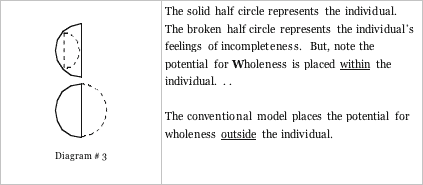
Shambhala Masters have been taught for centuries to strengthen and expand our own spirit and to fulfill our own Wholeness, as illustrated in Diagram #4.

Once again, the conventional model of couple relationships stresses the dependence one individual has on the other. Each incomplete individual completes the other. This dependence becomes a bond that secures the relationship. Note, the shaded area in Diagram #5. The greater the bond (size of shaded area), it is assumed the more likely that the relationship will endure through time. Consequently, we refer to this conventional model of relationships as “bonding.”
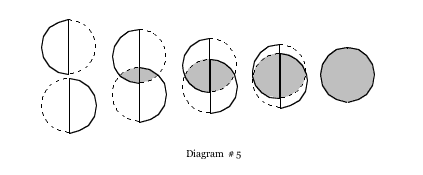
Our ancestors have known for centuries that when people choose to fulfill themselves from within, rather than through “bonding” with one another, a different kind of affiliation is possible. There is the possibility of creating relationships that strengthen both partners individually. Such relationships are not “bonded,” instead they are “bridged.” Shambhala relationships look like this:
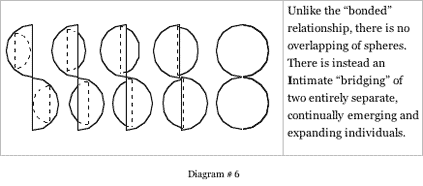
Shambhala bridging is Intimacy without dependency.
My ancestors realized that one of the advantages of Shambhala “bridging” is that there is no limit to the number of life-long, bridged affiliations I can enjoy — especially as I continue to expand myself. Diagram #7 illustrates how this is possible.
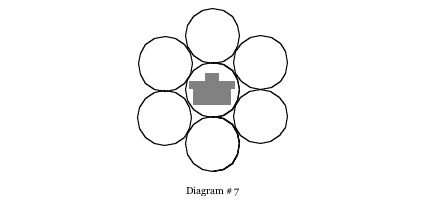
My teachers taught me that not everyone wants Intimacy with their Selves, with another or with numerous others. But for those who do want to Know their Selves and want to be Known by others, without having to limit themselves and their life experiences, Shambhala bridging is a powerful alternative to traditional bonding.

INVENTING ROMANTIC LOVE
Before Shambhala students can give ourselves permission to experiment with bridging, we must be knowledgeable about “bonding” and the romantic expectations surrounding it. Otherwise, we cannot separate our romantic pictures from “bonding.” We have been taught to believe romance cannot exist without bonding. We fear that if we do not “bond” we will grow old alone without love and romance in our lives. These lies and the fears that fuel them only let go of us as we become knowledgeable about the origins of “bonding” and how it came to be linked to romance.
Unknown to most people, romance and “bonding” have not always been linked. Originally, “bonding” was pragmatic business. It had one concrete and utilitarian purpose. In ancient times, the purpose of male-female bonding served the socio-economic interests of the group; it helped promote the survival of the group as well as the individual.
Consequently, the need to “bond” existed naturally, without the romantic enticements that are now attached to relationships. Bond individuals provided for the safety of women and children and maximized reproduction. Doing so continually enlarged the size of the group. The bigger the clan the better it could protect itself against wild animals, hostile intruders, and the harsh elements.
But, in our modern, vastly more populated, high tech civilizations it is no longer necessary for men and women to bond with each other to survive individually or as a group. Today, women can and do provide their own food, safety and shelter, while men can and do provide their own domestic comforts. Single women and single men can and do raise their children, alone. And, many groups of people have survived long enough to merge into one over-populated tribe.
Bonding is no longer a survival necessity for the individual or for groups of individuals, but it still remains a critical focal point for our social, economic, political, and religious institutions. Consequently, it has become necessary for these institutions to attach romantic idealism, idyllic fantasies, and chemical rushes to bonding to motivate people to pair off, whether or not it serves us as individuals or as groups.
Few realize that romance is man-made. It was invented. “Romantic” love originated in 11th Century Europe, in the south of France and Northern Italy. Troubadours invented courtly love themes which were unknown before the 11th Century.
Today these romantic fantasies, expectations, and chemicals are some of the first seeds planted in our minds, bodies, and emotions as children. Fairy tales give us only one way to think, perceive, and feel about love and relationships. My Teachers call this the Noah's Ark Perspective …“On this spaceship Earth I have to be paired up with someone of the opposite sex.”
These romantic fantasies, expectations, and the chemicals that go with them are the generators of the attractions that start relationships. They are also the glue that keeps relationships together long after the individuals involved have stopped liking, much less loving, each other. They glue couples together long after the relationship has stopped serving anyone's well-being.
Shambhala Masters know that there is much we need to learn about the manipulative power in these behavior controlling mechanisms if we are to become Self-directing. There are many skills we must acquire if we are to become Self-honoring. This section explores these behavior-controlling romantic fantasies, expectations, and chemicals, as well as the skills we need to authorize ourselves toward Shambhala ways of living, perceiving, thinking, feeling, and being.
My ancestors taught us that the tighter we “bond” to others, the more drag we create and the quicker the engine fueling the relationship burns out. Soon the romantic thrill of the chemically loaded speed boat ride becomes a burdensome, boring, slow trip to a living death, fueled only by submerged anger, resentment, and fears.

On the other hand, lives and relationships predicated upon Shambhala bridging, as opposed to romantic bonding, have entirely different purposes. Consequently, the participants travel an entirely different path. People participating in Shambhala bridging are not controlled by fantasy, genetic cueing, chemicals, or maintenance of the social/economic status quo. Instead, they are Consciously aware of the power inherent in each of these processes and elect to create bridged, rather than bonded, relationships to further Self-Intimacy. We gravitate towards individuals who challenge us to un-limit ourselves and reach for all we can be to and for our Selves. Shambhala students are taught to seek out individuals who are courageous, insightful, and diligent enough to require us to unlearn what we have been taught to blindly accept.
Shambhala students create relationships with people who dare to challenge the truth and functionality of romantic illusions, social expectations, genetic programming, and chemically controlled behavior. We associate with people who have the courage to see what they would rather not see, people who are muscle-minded enough to confront what they are tempted to run away from, people who already are or who can become fellow travelers and co-learners.
Shambala Masters require ourselves to learn how to bridge with others rather than bond to them. I emphasize require ourselves because it is not easy to redirect all the relationship behavior we have socially acquired and chemically learned. All our inherited instincts (instincts are socially learned and then can be passed on genetically from one generation to another) and everything we have been taught about relationships convinces us that the only, one way to love another is to become “symbiotic.” Our cultures teach us not to be too independent or too Self-sufficient or too Self-reliant or too Self-contained if we want to be loved. We learn all this early in childhood. It is a lesson we never forget.
As children our cultures repetitively teach us that it is loving to place our needs and feelings second to the needs and feelings of those we love. We learn quickly that putting our own needs first is unloving behavior. We also learn that it is loving to ignore the little things that bother us about the people dear to us. Our cultures teach us to look past our partner’s shortcomings: after all, “nobody's perfect.” We learn all too quickly not to speak about our feelings and thoughts. We learn that diplomacy is loving and that frankness is hurtful and impolite. Hence, truthfulness is unloving.
Our cultures teach us that the loving thing to do is to put smiles on our loved ones’ faces. We are taught how important it is to be what we think our loved ones want us to be. This learned hypocrisy gives us an errant picture of the love upon which we then base our most precious relationships. But, Shambhala Masters know that even more tragically, this learned hypocrisy severs us from the most truthful, authentic, insightful, creative, resourceful, inspirited, and empowered Core of ourselves.
LEARNING AND UNLEARNING … THE SHAMBHALA PATHWAY TO BRIDGING
To reunite with our sacred Cores, Shambhala students have much unlearning to do. We also have many skills to learn if we are going to create bridged rather than bonded relationships. Some people think that it is next to impossible to create Core-nurturing, non-symbiotic bridged relationships in a world where dependency is the only language of love. This, however, is not the case. There are many children, not to mention adults, who never felt “Loved” through symbiosis. They may have felt needed, or depended upon, or manipulated, or controlled, but not Loved.
To feel Loved we need to feel seen and known. We need to feel heard and received. We need to feel talked with rather than talked to. We need to feel fully experienced.
To feel Loved we need to feel admired and respected for who we are to our Selves rather than who or what we can be for another. We need to feel affirmed in what we are doing for our Selved, rather than in what we are doing for another. We need to know that it is our courage to stand alone, to be Self-contained, to be loyal first to our Selves that draws another to us, rather than our loyalty to another or our relationship.
CREATING PARITY
To feel Loved and to let others know they are Loved, Shambhala students go to great lengths to avoid symbiosis in relationships. One way we do this is by establishing financial and social parity. Financial parity can be created by keeping money separate and/or by creating openly agreed upon, short term, value-for-value exchanges ( i.e., I will do the cooking this week — if you will do it next week.). Social parity is created by examining social roles and gender expectations and making sure they do not blindly creep into our ways of interacting with ourselves and each other. Without this parity, candid disclosures that honestly reflect our conflicting, constantly changing needs, cannot be fostered. Without rigorously maintaining this parity, we can not risk telling one another about the energy dips all people experience within relationships. Without this zealously guarded parity, clear communication has no hope of germinating, much less surviving, over a lifetime.
In Shambhala bridging there is also a recognition of parity in personal Power. Personal Power is each individual’s immutable right and responsibility to be Self-contained, to answer first and only to one’s Self. This recognition of parity in personal Power eliminates the sense of duty, indebtedness, responsibility, and obligation to others that conventionally bonds people together, whether or not they are still drawn to each other for healthy reasons. Recognition of each person’s immutable right to personal Power places the responsibility for our life-choices and personal motivations at the center of the Self. Shambhala students know that you cannot hold me responsible for your life-choices, and I cannot blame you for mine. I am not in your debt because you gave up your career, your friend, your evening, or your favorite TV show to spend time with me. And, you do not owe me anything because I chose to make you important in my life.
The parity in personal Power, financial matters, and gender roles that goes hand-in-hand with Shambhala bridging, eliminates the contracts, promises, and commitments to be with each other forever … whether we want to be together or not. It eliminates the confusion as to why we are still together. Shambhala Masters never have to secretly ask themselves, “Are we still together because we said we would stay with each other and we don't want to be called quitters? Or are we together because our parents, friends and church would frown upon us separating? Do we stay with each other because of the finances — “two can live cheaper than one” and divorces are expensive? Or is it for the sake of the children? Or is it because the devil we know is less frightening then the devil we do not know?
This confusion does not exist in Shambhala bridging because bridging eliminates all these socially laden reasons for people coming together and staying together. In a Shambhala bridging, I know you are not with me to secure regular sexual servicing, because I do not give you, or anyone else, open, on-going, sexual access to me. Nor is keeping me sexually satisfied your responsibility. And, you know I am not securing you for financial favors because I have not allowed you to take responsibility for my financial well-being, nor do I take responsibility for yours. We each carry our own financial burdens, and we keep our financial matters with each other clean. I know you are not with me because of the domestic comforts I provide for you. And, you know I am not with you because you are my meal ticket. My and your personal well-being (physically, socially, emotionally, sexually, financially, and spiritually) are not dependent upon maintaining our relationship.
RELATIONSHIPS: A NEW PURPOSE AND MEANING
If we are not going to be sexually available to each other on an on-going, indiscriminate basis, and if we are not going to be responsible for each other's physical, social, emotional, financial, and spiritual well-being, then why would we want a relationship? For Shambhala students, the single, clearly agreed upon purpose of bridging is to strengthen the quality of our individual relationships with our Selves.
CREATING COMMUNITY

Shambhala bridged relationships also differ from bonded relationships in that Shambhala students focus on creating a community of people who nurture our abilities to reunite with the Cores of ourselves, as opposed to centering our lives around one individual and expecting one individual to meet all our needs and make us happy. Shambhala Masters realize that the more multi-faceted and multi-dimensional we are, the more unrealistic it is to expect one person to fulfill all our needs. Shambhala bridging gives us the freedom to create a lifetime full of deeply Intimate, multi-dimensional, multi-level relationships.
No one relationship, except the one I create with my Self, is critical to my physical, emotional, social, sexual, financial, or spiritual well-being. All my relationships contribute to my Self-loyalty. And, any relationship or experience that depletes my relationship with my Self is immediately and thoroughly re-examined. If our paths are diverging, or if we are no longer strengthening our relationships with our Selves, we respectfully step out of each other’s lives until we can enrich, as opposed to deplete, each others' Self-loyalty.
CONTRASTS BETWEEN BONDING AND BRIDGING
The chart that follows contrasts some of the major differences between bonding and bridging in the areas of personal identity, relationship priorities, responsibilities, purpose, expectations, and values.
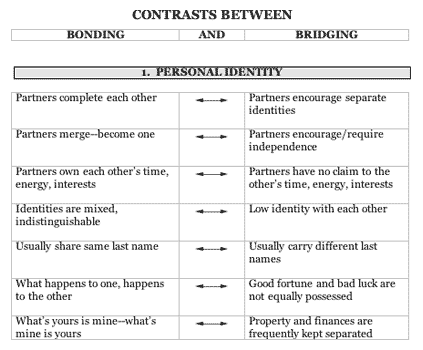
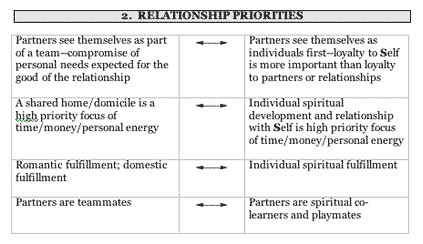
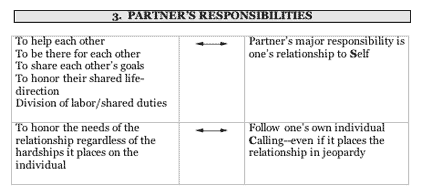
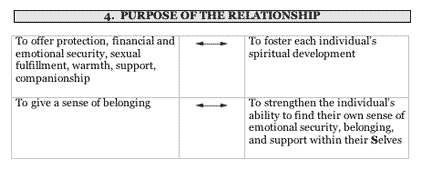
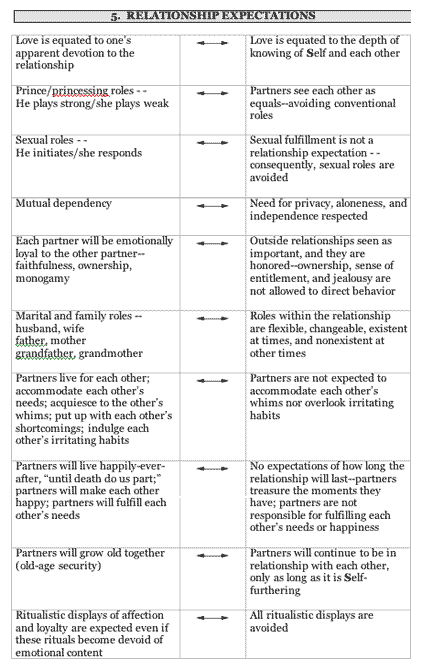
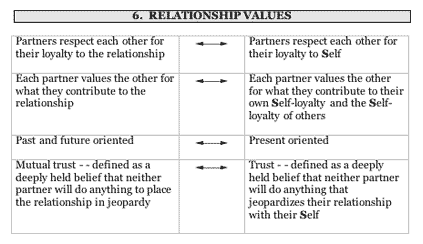
BURNING BRIDGES
Shambhala students become skilled, though never emotionally detached, at stepping out of each other’s lives. Though stepping out of a loved one's life is a deeply painful necessity at times, we have learned that holding on to others when we are no longer able to further each other’s relationships with our Selves only deepens and prolongs the pain. We have also learned that holding on to others when our paths are diverging results in resentment and anger. Both will eventually destroy all possibility of a Homecoming, even if Universal Timing dictates that our paths cross in the future.
Though there are millions of people hungering for the opportunity to Love and feel Loved, Shambhala bridging calls for special people. It calls for people who are mentally alive, aware, awake, cognizant, dynamic, and multi-dimensional. It calls for people who are resourceful, creative, capable, courageous, and able to co-exist independently. It calls for people who are compelled to reach for more than the conventional ways of seeing, thinking, and being: people who sense deep within themselves that Life and relationships, as they are conventionally experienced, are limiting. Shambhala bridging is for people who are o create new ways of Living and Loving.
*The word “Called,” is spelled with a bold capital “C.” The Shambhala Master uses bold capitals when referring to the primal, Core, spiritual essence of a word, as opposed to the conventional understanding of the word. Please consult the Master’s Glossary for the definition of this and other unfamiliar terms.
For more Shambhala Wisdom, visit www.shambhalablackbelts.com.
